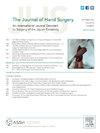屈指肌腱修复术后的放置固定被动活动疗法与主动活动疗法:随机对照试验的最短 5 年随访。
IF 2.1
2区 医学
Q2 ORTHOPEDICS
引用次数: 0
摘要
目的:关于屈肌腱修复术后的最佳康复计划,目前还没有达成共识。一些研究表明,主动活动后恢复更快,而另一些研究则在 12 个月后未发现主动和被动活动有任何差异。据我们所知,之前还没有随机对照试验比较过这两种方法的长期效果。这项随机对照试验比较了主动活动与被动活动相结合的长期疗效:这项研究共纳入了64例I区或II区屈肌腱损伤患者。手术后,患者被随机分配为主动活动或被动活动加固定。47名患者接受了至少5年的随访。评估内容包括活动范围、握力、关键捏力以及手臂、肩部和手部残疾(DASH)和 ABILHAND 问卷:结果:在最短5年的随访中,与主动活动组相比,接受原位负重被动活动治疗组的活动范围明显更好。此外,与术后1年相比,主动活动组的活动范围明显缩小,屈曲挛缩增加。从术后1年到最短5年的随访期间,两组患者的握力都出现了明显的恶化,但关键捏力没有变化。两组患者的DASH和ABILHAND评分在1年至5年的最低随访期间均有所改善:结论:与主动活动相比,屈肌腱修复术后采用定位牵拉法进行被动活动可获得更好的长期疗效:研究类型/证据级别:治疗 I。本文章由计算机程序翻译,如有差异,请以英文原文为准。
Passive Mobilization With Place-and-Hold Versus Active Mobilization Therapy After Flexor Tendon Repair: 5-Year Minimum Follow-Up of a Randomized Controlled Trial
Purpose
There is no consensus on the optimal postoperative rehabilitation program following flexor tendon repair. Some studies suggest a faster recovery after active mobilization, whereas other studies have failed to find any differences between active and passive mobilization at 12 months. To our knowledge, no prior randomized controlled trial has compared the long-term effects of these two approaches. This randomized controlled trial compared the long-term outcomes of active mobilization with those of passive mobilization in combination with place-and-hold.
Methods
Sixty-four patients with a flexor tendon injury in zones I or II were included in the study. After surgery, patients were randomized to either active mobilization or passive mobilization with place-and-hold. Forty-seven patients were available for the 5-year minimum follow-up. Assessments included range of motion, grip strength, key pinch, as well as the Disabilities of the Arm, Shoulder, and Hand (DASH) and ABILHAND questionnaires.
Results
At the 5-year minimum follow-up, range of motion was significantly better in the group treated with passive mobilization with place-and-hold compared with the active mobilization group. Furthermore, there was a significant deterioration in the range of motion and an increased flexion contracture in the active mobilization group compared with 1 year after surgery. Grip strength deteriorated significantly in both groups from the 1-year to the 5-year minimum follow-up, but key pinch did not change. In both groups, DASH and ABILHAND scores improved from the 1-year to the 5-year minimum follow-up.
Conclusions
Passive mobilization with place-and-hold following flexor tendon repair results in superior long-term outcomes compared with active mobilization.
Type of study/level of evidence
Therapeutic I.
求助全文
通过发布文献求助,成功后即可免费获取论文全文。
去求助
来源期刊
CiteScore
3.20
自引率
10.50%
发文量
402
审稿时长
12 weeks
期刊介绍:
The Journal of Hand Surgery publishes original, peer-reviewed articles related to the pathophysiology, diagnosis, and treatment of diseases and conditions of the upper extremity; these include both clinical and basic science studies, along with case reports. Special features include Review Articles (including Current Concepts and The Hand Surgery Landscape), Reviews of Books and Media, and Letters to the Editor.

 求助内容:
求助内容: 应助结果提醒方式:
应助结果提醒方式:


